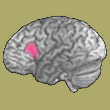Monday, 2 July 2012
Rethinking the Role of Broca’s Area in Language
 In 1861, Paul Broca observed a sizable lesion in the left inferior frontal cortex of a patient who had just died. This individual had been able to understand what was said to him, but had been unable to pronounce anything but the syllable “tan”. Subsequently, this same observation was confirmed in many other individuals, and Broca’s area, whose destruction results in this form of aphasia (now known as Broca’s aphasia), thus became associated with the production of language.
In 1861, Paul Broca observed a sizable lesion in the left inferior frontal cortex of a patient who had just died. This individual had been able to understand what was said to him, but had been unable to pronounce anything but the syllable “tan”. Subsequently, this same observation was confirmed in many other individuals, and Broca’s area, whose destruction results in this form of aphasia (now known as Broca’s aphasia), thus became associated with the production of language.
But the role attributed to Broca’s area has become far more complex since these initial observations were made. In addition to the production of language, this area is now also believed to be involved in certain semantic aspects of language. For example, Dr. Peter Hagoort’s research using brain imaging shows that the dynamic association of Broca’s area with the left posterior temporal cortex is necessary for understanding language.
Other brain-imaging experiments suggest that different cognitive processes (such as recognizing groups of words, making grammatical decisions, and formulating oral responses) activate different sub-areas of Broca’s area. These new neurobiological data have been used to develop functional models of Broca’s areathat make the simplistic dichotomy between production and understanding of language ever more tenuous.
![]() Dr. Peter Hagoort: CRLMB Distinguished Lecture Series
Dr. Peter Hagoort: CRLMB Distinguished Lecture Series
![]() In Milliseconds, Brain Zips From Thought To Speech
In Milliseconds, Brain Zips From Thought To Speech
![]() Dr. Gina Kuperberg: CRLMB Distinguished Lecture Series
Dr. Gina Kuperberg: CRLMB Distinguished Lecture Series
![]() On Broca, brain, and binding:a new framework
On Broca, brain, and binding:a new framework
![]() Retrieval and Unification of Syntactic Structure in Sentence Comprehension: an fMRI Study Using Word-Category Ambiguity
Retrieval and Unification of Syntactic Structure in Sentence Comprehension: an fMRI Study Using Word-Category Ambiguity
From Thought to Language | 1 comment








[…] Rethinking the Role of Broca’s Area in Language […]